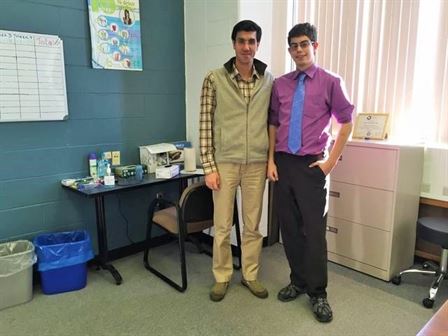
Amir Golnabi (left), assistant professor of the math department and co-director of The Center for Quantitative Obesity Research poses with Julian Litrento (right), senior nutrition student and weight loss counselor. Photo by Jennifer Leon
The Center for Quantitative Obesity Research is a math and science group located in Richardson Hall, room 262, that helps the patient obtain their weight loss goals by using mathematical models to objectively count calories.
Biology and nutrition students from Montclair State University guide students to lose weight for a one time fee of $60. The fee for faculty and staff is $80.
“Once the patient is accepted, we assign them to one of our counselors where they can schedule appointments on a weekly basis,” said Amir Golnabi, assistant professor of the math department and co-director of The Center for Quantitative Obesity Research, which is part of the weight management clinic.
“Dr. Diana Thomas created a mathematical model and in this model you put a person’s weight, height and BMI (body mass index) and what the person’s weight goal is,” said Julian Litrento, a nutrition student, who added that the machine is able to calculate how many calories a person needs to intake for a period of 24 weeks for them to reach their goal.
The mathematical model estimates where a person’s weight would be if they follow the advice given by the weight loss counselors. There are upper and lower boundaries which show if the patient is eating too many calories or eating less calories than needed.
“We have something called ‘the red zone’ which is when a person is not eating enough calories and losing too much weight,” said Litrento. “That is when we make adjustments accordingly.”
She continued, “We think self-report is not very reliable because a lot of people tend to under-report what they are eating and then wonder why they are not losing the weight. This is especially true for woman because it’s a social taboo to not eat too much.” He explained that The Center for Quantitative Research helps its patients by going as far as providing healthy and low-calorie recipes.
At the clinic, the procedure is a lot like what you experience at a doctor’s office. Patients even go as far as changing into a set of clothing such as shorts and a shirt. The patient is then weighed on a scale and measured by their waist circumference, which is a big indicator of fat loss.
Using the bioelectric impedance analysis (BIA) machine, a small yet harmless current runs throughout the body, which allows the machine to measure the resistance (impedance) when the current travels through the body. The machine provides an estimated measure of the fat percentage in the patient’s body.
The weight loss counselors then use a portable ultrasound that shows the changes in skin and fat over a period of weeks. This ultrasound illustrates how the patient is actually losing fat instead of muscle mass.
The clinic was previously only for faculty and staff of Montclair State, but as of fall 2016, it has been open for students and is currently looking to increase the number of patients and the number of student counselors.
“We don’t have any psychology students with us, but we are also thinking of expanding our services for patients dealing with psychological problems [that come with weight loss],” Golnabi said. “If they are, we advise them to go see Counseling and Psychological Service.”
Rajesh Gautam, a visiting scholar from India who is researching obesity and prevalence of obesity globally for his post-doctorate at Montclair State, said that in India, there is a bigger focus on plant-based nutrition while in America most foods are microwavable, or come in a can.
“I see so many students in classrooms carrying around big energy drinks,” Gautum said. “That is what we call empty calories. There is a higher intake of fatty substances like sugar and carbs and that is what is leading to weight gain.”
Golnabi said that, as a young college student, he would prepare his meals at home because it was healthier and more cost efficient. He said, “Even if you’re very busy, just keep the right ingredients in your fridge. Avoid certain things and develop good habits. If you want to be healthy, there are no excuses. Weight loss is not a one day or one-week program. An individual needs to be mindful and be prepared to lose weight.”


